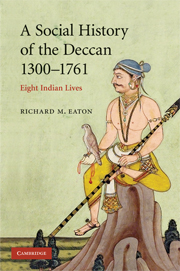Book contents
- Frontmatter
- Introduction
- 1 Pratapa Rudra (R. 1289–1323): the demise of the regional kingdom
- 2 Muhammad Gisu Daraz (1321–1422): Muslim piety and state authority
- 3 Mahmud Gawan (1411–1481): Deccanis and Westerners
- 4 Rama Raya (1484–1565): élite mobility in a Persianized world
- 5 Malik Ambar (1548–1626): the rise and fall of military slavery
- 6 Tukaram (1608–1649): non-brahmin religious movements
- 7 Papadu (fl. 1695–1710): social banditry in Mughal Telangana
- 8 Tarabai (1675–1761): the rise of Brahmins in politics
- Select bibliography
- Index
- Plate Section"
- References
1 - Pratapa Rudra (R. 1289–1323): the demise of the regional kingdom
Published online by Cambridge University Press: 28 March 2008
- Frontmatter
- Introduction
- 1 Pratapa Rudra (R. 1289–1323): the demise of the regional kingdom
- 2 Muhammad Gisu Daraz (1321–1422): Muslim piety and state authority
- 3 Mahmud Gawan (1411–1481): Deccanis and Westerners
- 4 Rama Raya (1484–1565): élite mobility in a Persianized world
- 5 Malik Ambar (1548–1626): the rise and fall of military slavery
- 6 Tukaram (1608–1649): non-brahmin religious movements
- 7 Papadu (fl. 1695–1710): social banditry in Mughal Telangana
- 8 Tarabai (1675–1761): the rise of Brahmins in politics
- Select bibliography
- Index
- Plate Section"
- References
Summary
With all these people of various skills serving him, and surrounded by five thousand attendants who showered him with gold and riches and sprinkled him with scented water from golden bottles, Prataparudra sat in the great assembly and ruled the kingdom, considering the petitions of the local lords and entertaining the requests of ambassadors.
Prataparudra Caritramu (early sixteenth century)THE RAJA'S NEW CLOTHES – AND TITLE
A broad geo-cultural axis stretches along the spine of South Asia from Lahore to Delhi to Hyderabad in the central Deccan plateau, with extensions running from Delhi east to Patna and southwest to Ahmadabad (see Map 1). Forged by ancient trade and migration corridors linking South Asia with the Iranian plateau, this axis facilitated the flow of cultural currents that greatly accelerated over the course of the past millennium. As a result, there emerged along these corridors a set of related traits that have persisted down to the present: Persian styles of architecture, music, art, dress, technology, cuisine; and a history of the Persian language used for administrative purposes, often followed by forms of spoken Urdu. Not least, new ideas of political and social organization were carried along the corridors of this Indo-Persian axis.
The story of Pratapa Rudra, the last sovereign of the Kakatiya dynasty in the eastern Deccan (1163–1323), forms in a sense the first chapter in the larger story of the extension of this axis from Delhi to the Deccan plateau. For this king's extraordinary career, and tragic fate, bridges the appearance of two very different kinds of state system in Deccani history. One of these was the “regional kingdom,” the sort of polity found on the Deccan between c. 1190 and 1310, and represented by the Kakatiyas under Pratapa Rudra and his dynastic predecessors. The other was the “transregional sultanate,” a type of polity that, newly introduced to the Deccan along the Indo-Persian axis from north India during Pratapa Rudra's reign, would remain the Deccan's dominant form of state system until the coming of British power in the eighteenth century.
Keywords
- Type
- Chapter
- Information
- A Social History of the Deccan, 1300–1761Eight Indian Lives, pp. 9 - 32Publisher: Cambridge University PressPrint publication year: 2005
References
- 1
- Cited by



